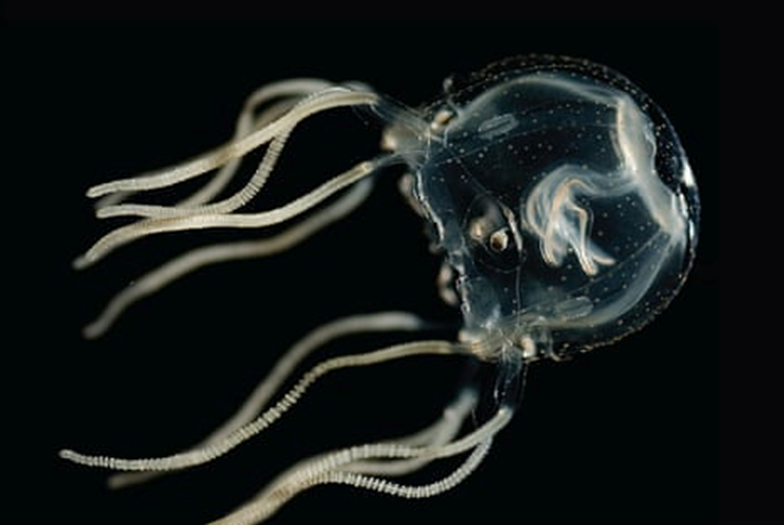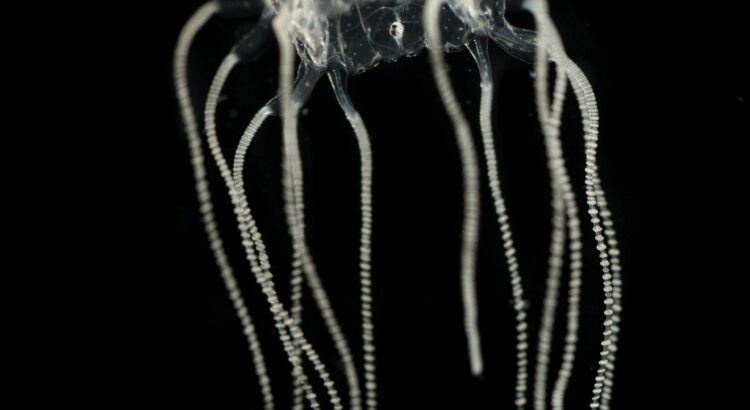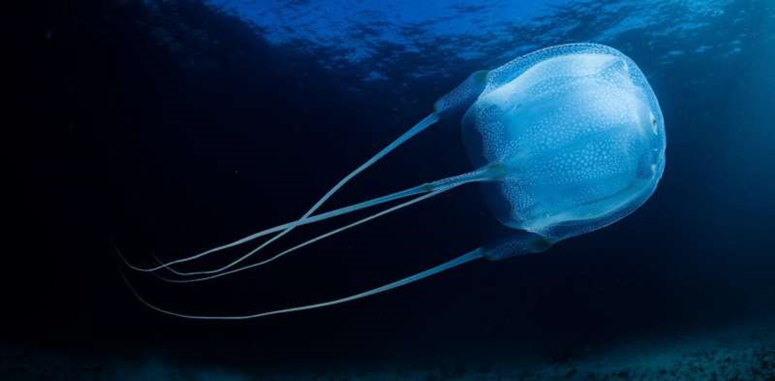Learning even without a brain is possible! Example with jellyfish

The Caribbean box jellyfish is capable of complex learning, even without a brain. Credits: Wikipedia.
No need for a central brain to be capable of advanced learning! A new study conducted on a tiny jellyfish, the Caribbean box jellyfish, has shown that the animal is capable of learning from its past experiences, and quickly!
The jellyfish is an astonishing and mysterious animal... A new study has just confirmed this by showing that a certain species, the Caribbean box jellyfish, was capable of relatively complex learning, even though it has a fairly rudimentary nervous system. . The scientists published their results in the journal Current Biology.
The Caribbean box jellyfish, a species no bigger than a fingernail
The Caribbean box jellyfish, Tripedalia cystophora, belongs to the box jellyfish family. These animals take their name from their gelatinous body, the hat or umbrella, shaped like a box.
Tripedalia cystophora mainly roams the seas of the Caribbean and the central Indo-Pacific. This jellyfish mainly lives in mangroves. It is tiny, measuring only about 1 cm, so barely the size of a fingernail.
Caribbean box jellyfish have a complex visual system. On their umbrella, they have four structures, called rhopalies. The latter are cylindrical in shape and contain numerous receptor organs, particularly sensitive to light. These four rhopalia consist of a group of six eyes, with different functions.
Thanks to these 24 eyes, the Caribbean box jellyfish exhibits complex behaviors. She can thus avoid obstacles, swim quickly in a particular direction or even stay level with skylights.
This complex visual system could be compared to a central nervous system. It is therefore suggested that the nerves of the rhopalian nervous system could be responsible for processing visual information.
For the record, in this family of box jellyfish there is a species called the sea wasp. Indeed, Chironex fleckeri, whose body, in adulthood can be as big as a watermelon, has mini stinging harpoons on its tentacles which it uses to catch and paralyze its prey.

However, this venom is capable of paralyzing the heart muscles of stung animals, including humans. It is also responsible for around 50 deaths per year.
An astonishing jellyfish… capable of associative learning!
The Caribbean box jellyfish therefore does not have a “central brain”, yet it is capable of learning complex things!
Thus, scientists thought that associative learning and the adaptation of behavior (avoiding touching a hot plate so as not to burn yourself, for example) only concerned biologically complex animals. Animals that have a rather large “real” brain (mammals, birds, etc.).
Associative learning is a process in which an individual learns to produce one or more given behaviors in response to a stimulus. This is done by mental association between the stimulus and the response. Thus, a link will truly be established between the two phenomena. This learning therefore suggests that there is a change in behavior which is acquired by the individual.
For this link to be made, there must first have been habituation or awareness of the existing relationship between the two elements. Associative learning therefore indicates that there is real consideration of past experiences.

Among associative learning, we find in particular classical or Pavlovian conditioning. The latter will lead the individual to associate two stimuli, one neutral and the other unconditional, with the same response.
Thus, in the case of Pavlov, he had conditioned his dog so that he would start to salivate the moment he heard the sound of a bell (initially neutral stimulus). Only, previously, Pavlov had repeated the same gesture: giving a food reward to the dog when he rang the bell. When seeing food, the dog naturally salivated (unconditional stimulus). The dog then associated the bell with food and began to salivate upon hearing it, even without seeing the bowl!
The team of researchers was therefore amazed by the capacity of the box jellyfish. So, of course, they don't start drooling over treats, but they are still capable of learning!
!Learn to avoid obstacles, not so stupid
Jan Bielecki and his colleagues at the University of Kiel wanted to demonstrate that jellyfish could acquire the ability to avoid obstacles through associative learning.
To do this, the team created an experimental environment, imitating mangroves, the natural habitat of box jellyfish.

They thus dressed the walls of a round pool with white and gray stripes. The latter recall the vertical roots of mangrove trees, the emblematic trees of mangroves. But why not black bands? The gray color will more easily “deceive” the jellyfish, making them believe that the “roots” are further away than in reality.
The scientists observed the jellyfish in this environment for about 7 minutes.
Initially, the animals frequently encountered the gray bands, which they believed to be far away. But, by the end of the experiment, the jellyfish had increased their average distance from the wall by about 50%. Additionally, they quadrupled the number of successful pivots to avoid collisions. These results therefore indicate that jellyfish are capable of learning from their experience through visual and mechanical stimuli.
The researchers wanted to go further and understand the process underlying this associative learning in jellyfish, which have no brain.
!Everything happens in the rhopalies of the jellyfish
“If you want to understand complex structures, it’s always good to start as simply as possible.” In any case, this is what one of the authors of the study, Anders Garm, explains. “By looking at these relatively simple nervous systems in jellyfish, we have a much better chance of understanding all the details and how they come together to execute behaviors.”

Scientists have thus looked into the famous rhopalia of box jellyfish. They thus noticed that the frequency of the pacemaker signals which govern the pulsating movement of the jellyfish increases when the animal moves away from obstacles.
In a second experiment, they showed the immobile jellyfish moving gray bars. It was a way of imitating the animal’s approach to these “roots”. The animal did not react, however, considering this obstacle too far away.
The scientists then trained the sensory centers with weak electrical stimulation. The latter simulates the shocks of a collision and the resulting stimuli. The rhopalies then generated obstacle avoidance signals facing the gray bands. This therefore shows that the jellyfish requires the combination of visual and mechanical stimuli for good associative learning and it is the rhopalies which serve as the learning center.
Scientists are particularly amazed by the speed at which box jellyfish learn! This is roughly the same rate as more “complex” animals. Finally, even a very simple nervous system is capable of carrying out advanced learning. This could therefore be an extremely fundamental cellular mechanism, appearing at the dawn of the evolution of the nervous system.
Source: websites

